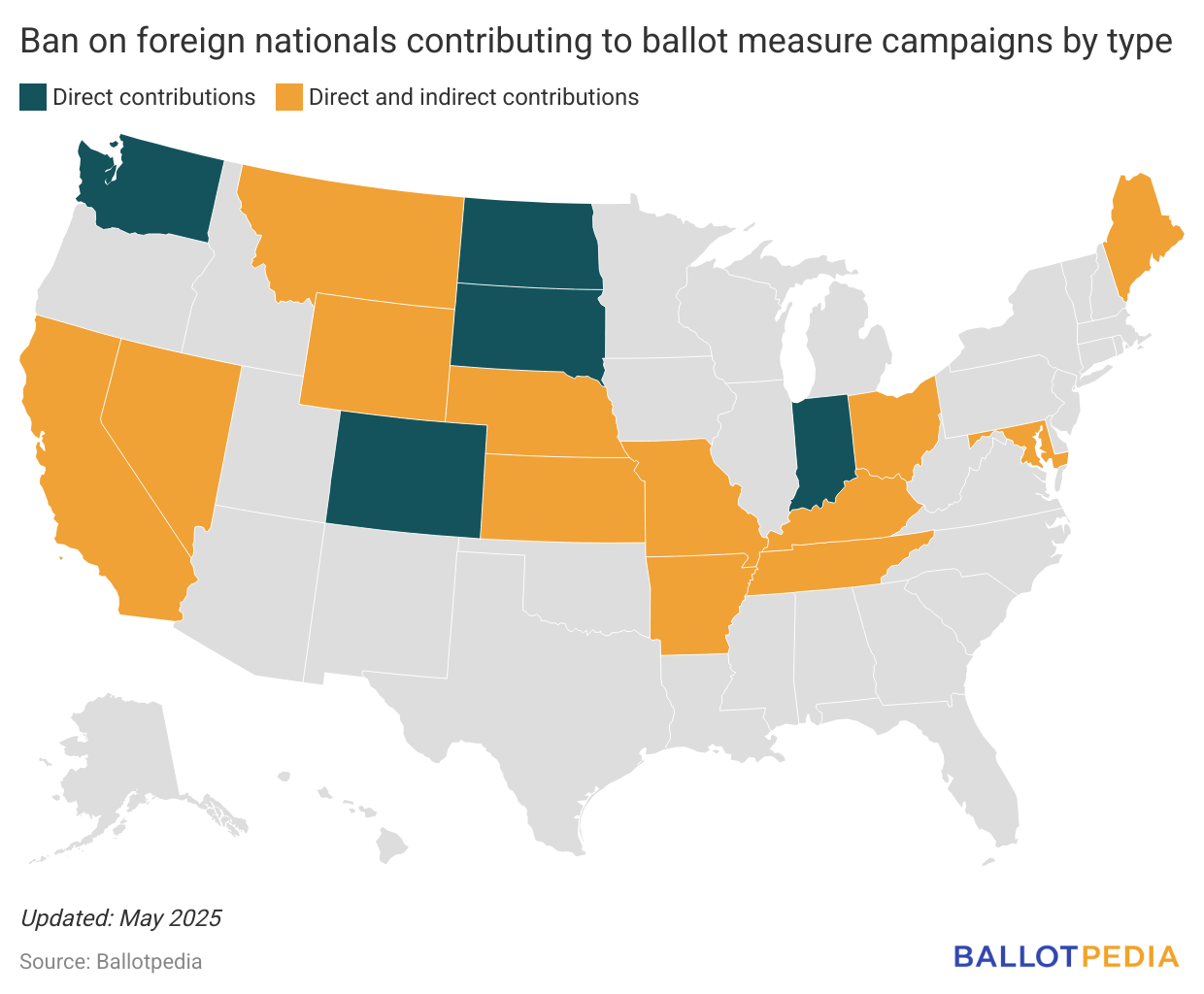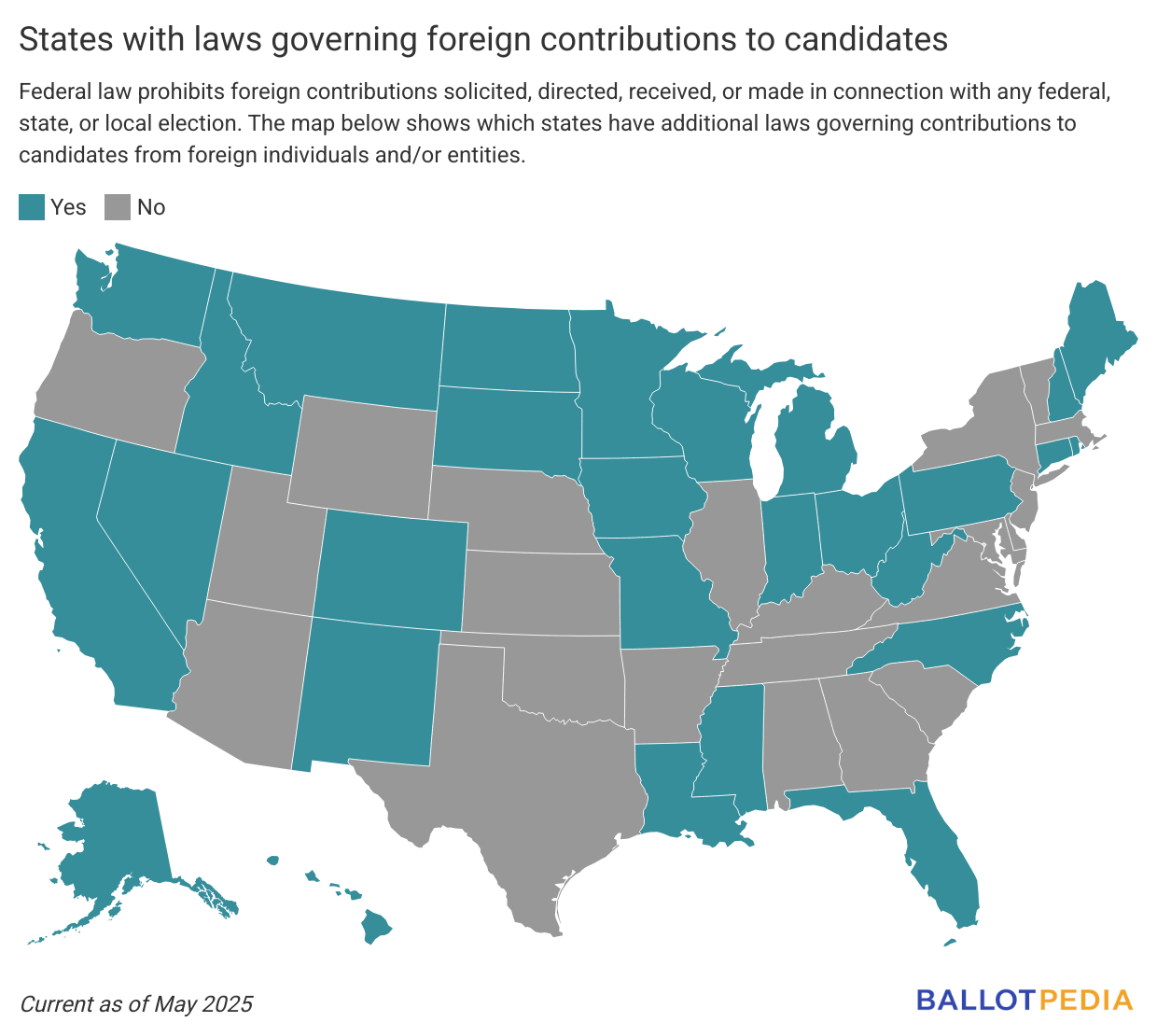Welcome to the Friday, May 23, 2025, Brew.
By: Lara Bonatesta
Here’s what’s in store for you as you start your day:
- A look at the laws governing foreign spending on candidates and ballot measure campaigns
- Join Ballotpedia Society
- Judicial power in focus, part 2: the federal judiciary, by Leslie Graves, Ballotpedia Founder and CEO
A look at the laws governing foreign spending on candidates and ballot measure campaigns
This year, several states have acted on legislation about the issue of foreign spending on candidate elections and ballot measures. Today, we’re taking a closer look at this topic.
Ballot measures
On May 21, Tennessee Gov. Bill Lee (R) signed House Bill 0888, making Tennessee the seventh state this year to ban foreign spending on ballot measure campaigns. The others are Montana, Arkansas, Indiana, Kansas, Kentucky, and Wyoming. This brings the total number of states with such bans to 17.
According to the bill’s official summary, HB0888 prohibits political campaign committees from directly or indirectly receiving, soliciting, or accepting contributions from prohibited sources, including foreign nationals. The bill also prohibits foreign nationals “from directing, dictating, controlling, or directly or indirectly participating in the decision-making process of any person with regard to that person's activities to influence a measure, such as decisions concerning the making of contributions or expenditures to influence a measure.”
On April 16, the Tennessee Senate voted 28-1 to pass HB0888. All 27 Republicans and one Democrat voted in favor, and one Democrat opposed it. On April 21, the Tennessee House passed the bill 75-15. Seventy House Republicans and five Democrats supported it, and 15 Democrats opposed it.
On May 13, Montana Gov. Greg Gianforte (R) signed House Bill 818, which prohibits foreign nationals from making a contribution or expenditure in connection with any statewide ballot measure campaign either directly or through an intermediary.
The issue of foreign spending in ballot measure campaigns arose in Montana during the 2018 election cycle, when an Australian firm, Sandfire Resources, contributed more than $23,000 to the “Stop I-186 to Protect Miners and Jobs” committee that opposed I-186. The measure would have established new requirements for hard rock mine permits. It was defeated 55.6%-44.4%.
In July 2021, the Federal Election Commission affirmed in a 4-2 decision that foreign nationals, including individuals, corporations, and governments, can contribute to ballot measure campaigns.
Most states’ bans apply to non-U.S. citizens, lawful permanent residents, foreign governments, foreign political parties, and foreign companies. The laws in Montana and Tennessee also exempt certain U.S. entities wholly or majority owned by foreign nationals, if they meet certain criteria.
The Montana House passed the bill 56-44, with all but two Republicans voting in favor and all Democrats opposing it. The Senate passed it 37-13, with six Democrats and 31 Republicans in support, and one Republican voting with the remaining Democrats.
Of the 17 states that have enacted bans, five have banned direct contributions, while 12 have banned direct and indirect contributions from foreign individuals or entities. Four states that enacted laws banning foreign spending on ballot measure campaigns did so through ballot measures: Colorado, Maine, Missouri, and North Dakota.
In 2017, the U.S. District Court of Western Missouri ruled that Missouri's ban was unconstitutional, and the Eighth Circuit Court of Appeals upheld the ruling in 2018. On May 15, 2025, the Missouri Legislature passed Senate Bill 152, which would ban foreign nationals from directly or indirectly contributing to ballot measure campaigns. The bill is awaiting the governor's signature.

Candidate elections
The Federal Election Campaign Act of 1971 (FECA) replaced existing federal campaign finance laws and required campaigns to file quarterly disclosure reports of contributions and expenditures. In 1974, Congress amended the act to impose contribution and spending limits on campaigns and to forbid contributions from foreign nationals.
In addition to the federal law, 26 states have additional laws covering campaign contributions to candidates from foreign individuals or entities.
These laws vary state-by-state, with some containing no additional restrictions beyond federal law and others establishing additional constraints on contributions from foreign nationals, businesses, and other entities to candidates or candidate committees.
For example, states such as Hawaii prohibit contributions from domestic subsidiaries of foreign corporations and domestic corporations with foreign national owners.
State laws also vary in how they define foreign individuals or entities.

Background: Why are candidate and ballot measure foreign spending laws different?
In 1978, the Supreme Court ruled in First National Bank of Boston v. Bellotti, that “Referenda are held on issues, not candidates for public office” and that spending on ballot measure campaigns is similar to issue advocacy, such as lobbying, in the lawmaking process.
In its 2012 ruling in the case Bluman v. FEC, the Supreme Court reaffirmed that under the Federal Election Campaign Act (FECA), foreign nationals were prohibited from making contributions to candidates but that FECA "does not bar foreign nationals from issue advocacy,” which includes ballot measure campaigns.
The Federal Election Commission, following the court's orders, has held that ballot measure campaigns are not regulated under FECA.
Click on the following links to learn more about the laws governing foreign spending in candidate elections and ballot measure campaigns.
Join Ballotpedia Society
With 99% of elected officials serving at the local level, having accurate, unbiased election information is more important than ever.
This year, we’re providing voters in 26 states not just with names, but with something truly meaningful – we call it “robust data.” What does that mean?
It means we gather essential information that goes beyond just names and party labels. We provide voters with information like endorsements, campaign themes, pledges, and ratings. This all does one thing: it helps voters make confident, informed decisions at the polls.
The Ballotpedia Society members make monthly donations to support our efforts covering more elections and providing voters with the information they need to vote with confidence. Click here to join and make your donation today.
Judicial power in focus, part 2: the federal judiciary

This is part two of our look at the U.S. judicial system. For part one, click here.
One thing truly unites Americans, regardless of their political views: they enjoy a good argument over the meaning of the Constitution, and aren’t shy about debating the practical, political, and constitutional merits of U.S. Supreme Court decisions.
There’s more to the federal courts than the nine-member Supreme Court. More than 1,700 federal judges hear arguments in about 400,0000 cases every year. About half of them are presidential appointees (because presidents don’t appoint federal magistrates or bankruptcy judges, for example).
But beyond those basics, what do people really know about the federal court system and its central role in our government? For answers, I asked Myj Saintyl, a staff writer for Ballotpedia’s Elections Team and the primary writer of our U.S. Supreme Court newsletter, Robe and Gavel.
Today, Ballotpedia has a comprehensive library of every U.S. Supreme Court decision issued since the 1790s — roughly 30,0000 decisions, and counting. I asked Myj what has surprised her the most about the cases she’s reviewed and catalogued. Her answer was a surprise to me, too.
“Once a year, after the Supreme Court’s (SCOTUS) calendar closes until the next term, I review the justices’ agreement rates with each other. And although I’ve done this review a few times now, I’m always surprised at how often they agree.”
“For example,” Myj said, “according to a report from Empirical SCOTUS, Justices Clarence Thomas and Sonia Sotomayor have the lowest agreement percentage of the justices. And yet they still vote similarly in 50.9% of cases. In a time when some may feel that politics and the courts have become increasingly polarized, it’s a reminder that consensus is still possible.”
And while voters can’t directly elect federal judges, the decisions we make at the ballot box determine who selects and approves those judges and the decisions those courts will make.
Myj used an analogy to describe how it all works: “Self-governance is like riding a bicycle. Moving forward requires work. Most cases that get to the Supreme Court have to go through a lower court. Sometimes, Supreme Court cases even originate from state supreme courts. And those cases come from lower courts within the state.” And as we read in the first part of this series, many of those state judges are elected.
Myj said, “At the federal level, the president makes judicial nominations that require Senate confirmation. Ballotpedia has all the information voters need to get informed about every elected official and every judge involved in this enormous, complex, and essential process.”
As I said in the beginning, Americans love to debate the latest Supreme Court decision. But understanding the role courts play in our system of government requires more than an opinion. Like Myj said, it requires work. Ready to get started? Subscribe to Robe and Gavel.

